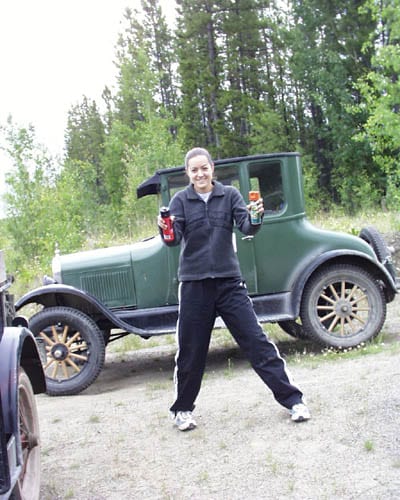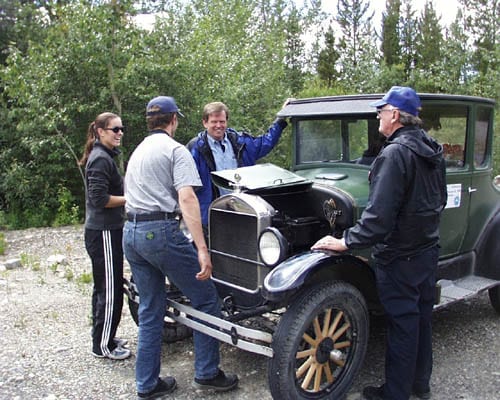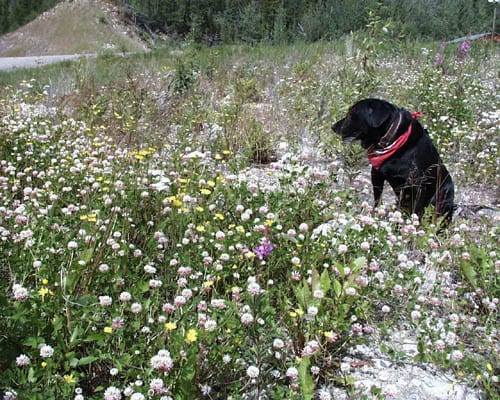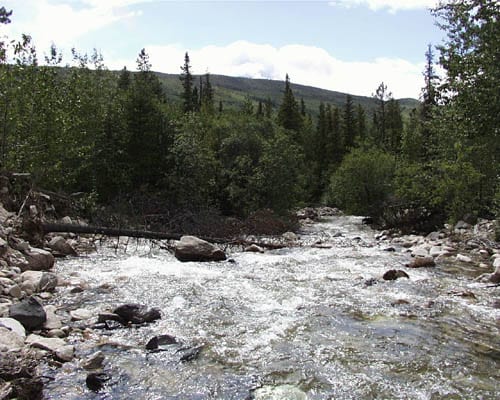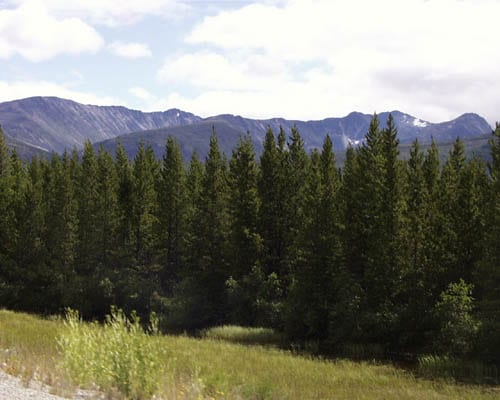Day 50 – July 25, 2001 – We start our 8th week today, our 50th day. In some ways, it seems like we have been on this road forever. At the same time, it doesn’t seem possible that we only have three more weeks to do all the things we still plan to do before we get home. This has been a fairly uneventful day. We drove from Teslin to Watson Lake (Yukon Territory) and, since we had come a little farther than planned last night, we had less than 200 miles to drive today. The drive was a pretty one, more trees and rolling hillsides and lakes and rivers. We crossed the Continental Divide but it wasn’t a terribly high point like it is when you cross the Divide in Colorado. The unusual thing about the Divide here is that the rivers flow on the west side to the Yukon and out to the Bering Sea. On the east side, the rivers run in a northerly direction, ultimately emptying into the Arctic Ocean. The river on the eastern side of the Divide is the Rancheria, a gorgeous wide river with a beautiful green color. It empties into another river, than that into another, twisting and turnings its way along the side of the Alcan Highway. The river actually served as the directional for the plotting of the highway, saving hundreds of miles from the mountainous path the Corps of Engineers originally plotted.
Once again we were struck by the vast acreage out here with no development on it. We’ve seen this in most of Alaska and in the part of Canada that we’ve visited. Every 25-75 miles, we will come up on a roadhouse (usually a small cafe, gas station, 4-room motel, and RV camp (no services). Every 100 to 200 miles we come across a small community of 50 people to 150 people. This town of Watson Lake is the largest community in this section of the road, and it has a small grocery, a laundromat, four motels, and a gas station. It has a center where they do a program about the Northern Lights and an excellent program about this area of the Yukon. Oh yes, it has a poorly stocked and very expensive NAPA store. When Ben asked there about the next closest NAPA that might have the parts he wanted, he was told that there was one in Whitehorse (over 300 miles back) or in Ft. Nelson (over 300 miles ahead). We have had numerous discussions among ourselves as to why people choose to live here. What do they do for a living? Some of them obviously benefit from the tourists – they charge a lot because the tourist season is so short and the accommodations are so few. But they live here year round. How do they pay their mortgage? Where do they send their children to school? What do their teenagers do when it is Saturday night and they are fifteen? How do they get by in the winter when it drops to -30 degrees or lower? When it is nearly dark all day long? When it rains every day for a month? When they don’t have milk for breakfast?
We’ve talked to a lot of people up here: waitresses and owners of little cafes, clerks at the gas stations, members of car clubs. “What brought you here? Do you like living here?” And, almost every time, the answer is “we came for the lifestyle”. They came here because it was open and uncrowded; because there is very little government influence on their daily lives; because even though the winters are long and dark, they can see a million stars and, frequently, the northern lights. The mountains here are beautiful, the lakes and streams are filled with fish, the woods have animals for food and trapping. They can ski and snowmobile in the winter and boat in the summer. They have adapted to this rugged and more difficult life because this is what they want. If they didn’t like it, they would have returned “outside” years ago. Even in the cities, people refer to the rest of the U.S. as the “outside”. They may have a grocery and a hospital and public schools but their life is still different from their counterparts in the lower 48 states. And they like it that way.
Part of the pleasure of travel is seeing a way of life that is different from your own. The people we’ve met, with few exceptions, have been kind and courteous to us. They have offered help when we needed it, significant help that is surprising when it is offered by a stranger. The scenery is incredible, beyond my ability to describe. The vastness of it will overwhelm you. None of us have felt compelled to move here but all of us are very glad we came.
